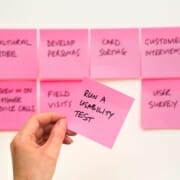Avoid These 10 Mistakes When Developing Your First Mobile App
Mobile apps have transformed how we communicate, interact, shop, and exchange information. From online food shopping to e-ticking, mobile apps have changed how enterprises do business. These pocket-sized tools have transformed how consumers access information, defining consumer shopping habits, and purchase preferences.
Developing your first app is exciting; the prospect and thoughts of bringing your ideas to life is thrilling to most entrepreneurs. However, this process comes with its fair share of challenges. It requires meticulous planning, expert execution, and continuous improvement.
This article walks you through ten mistakes to avoid when developing your first app, equipping you with the knowledge, expertise, and skills required to know what sets an excellent app apart.
USE OUR APP COST CALCULATOR TO ESTIMATE THE COST TO BUILD YOUR APP!
1. Lack of a clear purpose
The first step to developing a successful app is defining your purpose. Most successful apps are reputable for solving common problems. Think about Facebook, Instagram, Spotify, and LinkedIn, and you realize just how robust and excellent these apps are at solving a diverse set of problems.
Remember that at the heart of mobile app development lies a clear-cut purpose and the audience in mind. Defining a clear purpose acts as the North Star that guides your app’s design, development, and functionality. Without this clarity, you risk developing an app that lacks a clear direction, leading to confusion and ultimately affecting user experience.
2. Failure to do market research
In the ever-evolving field of mobile app development, the popular phrase ‘knowledge is power’ takes center stage. One mistake a budding mobile app developer can make is failing to conduct market research and missing out on the crucial insights that this research provides.
It’s important to acknowledge that when it comes to mobile app development, market research is not just a formality; it’s a source of informed decision-making at every stage of the process. By skipping market research, you’re venturing into an unknown area without a map. Market research provides a clear roadmap on what to do and avoid in building a successful app.
3. Neglecting user experience
The user experience is the engine that powers your app. Think of it as the fuel in the engine. Neglecting your user experience is similar to building a mansion on a shaky foundation. The success of your app hinges on more than just its primary features; it’s about crafting an engaging, intuitive, and seamless user experience that leaves a lasting impression. Neglecting this critical aspect of mobile app development is akin to alienating users and squandering your app’s immense potential.
When developing your first app, remember the user design underlines its success and adoption. Developing your app means understanding your users’ needs, preferences, and options and optimizing opportunities that fulfill these needs. When users find value in your app, they’re likely to recommend it to others, creating an expansive platform for adoption. Apps that emphasize user-centered design forge lasting relationships with their prospects, fostering trust and loyalty with their audiences.
4. Ignoring platform and device compartibility
Optimizing your app for iOS, Android, and other operating systems is critical in a world where users have diverse devices and several OS preferences. Each platform – Android, IOS, and others – has its interface conventions, design guidelines, and user expectations. Therefore, by tailoring your app’s experience with each of these operating platforms, you’re demonstrating your commitment to building native experiences that resonate with diverse users.
It’s important to note that ensuring consistent operation across multiple platforms is non-negotiable. Inconsistent performance leads to frustration, disgruntlement, and abandonment. To tackle this challenge, adopt the following practices:
- Responsive design. Implement responsive design principles that adapt your app’s layout and functionality to different screen orientations.
- Performance testing. Conduct performance testing by testing your app on different devices to identify performance bottlenecks.
- Adaptive UI. Design a UI that gracefully adapts to different screen sizes, ensuring people have a positive user experience.
- Platform-specific customization. Embrace platform-specific customization to leverage unique features and design principles of each platform.
- Regular updates. Continuously update your app to accommodate changes in user feedback, OS updates, and device specifications.
The importance of customizing your app cannot be overstated in an era where users span many platforms and operating systems.
5. Overloading your app with features
As a first-time app developer, you may be tempted to overload your app with features to make it all-encompassing. However, falling to this temptation and overloading your app with features can be a major pitfall, resulting in a compromised user experience and overall app failure. You must strike a balance between comprehensive offerings and a clean, user-centric interface.
Other than attempting to be a jack-of-all-trades, successful app developers focus on a limited set of app features, optimizing basic functionalities without compromising user experience. By offering basic features, you’re prioritizing a seamless user journey, thus improving the likelihood of app adoption.
In developing a successful app, remember that quality triumphs over quantity. The inclination to overload your app can be counterproductive, harmonizing your app’s user experience with a limited set of features.
6. Poor performance and speed
In this fast-paced world where instant gratification is the norm, delays and sluggish performance can spell disaster even for the most creative apps. The importance of developing an app with faster loading times and smooth performance cannot be overstated.
A smooth and flawless experience combined with faster loading times is the holy grail of a successful mobile app. Users have become increasingly accustomed to fast-performance applications and expect nothing less. An app that loads quickly and responds faster to customer requests will build trust and foster loyalty. The attributes of speed, efficiency, and responsiveness contribute to positive responses and organic growth through word-of-mouth referrals.
Here are tips for optimizing app performance:
- Efficient coding. Write clean and precise code that minimizes resource consumption and increases efficiency.
- Image compression. Compress images to reduce loading times without affecting image quality.
- Caching. Utilize caching to store frequently used data, reducing the need for frequent data retrieval activities.
- Minimize animations. Minimize animations that can affect your app’s loading speed.
- Asynchronous loading. Load content asynchronously to ensure the interface remains responsive even when retrieving data.
- Performance testing. Regularly test your app’s performance on different devices and on varying network conditions to identify bottlenecks.
- Optimize network requests. Reduce the number of network requests and use techniques such as data prefetching to enhance user experience.
- Update management. Implement update management to ensure your app remains compatible with new OS updates and different device capabilities.
The term ‘time is of the essence’ holds profound significance in app development. So, optimize your app for speed and efficiency when developing your first app.
SCHEDULE A CONSULTATION WITH AN APP DEVELOPMENT EXPERT TO GET A CUSTOMIZED QUOTE!
7. Neglecting quality assurance and user testing
In mobile app development, user testing and quality assurance cannot be overstated. Transcending from app inception to a polished app requires a rigorous process of refining, testing, and addressing potential problems or issues. Neglecting user testing and quality assurance can impair your app’s performance, tarnishing your brand and business reputation.
Quality assurance ensures your app responds to the latest testing requirements, optimizing for better performance and new updates. Most importantly, quality assurance helps to highlight issues that can be addressed later in the development stage. Constant testing and evaluation help to expose loopholes that can uncover hidden problems in your app performance.
8. Inadequate marketing
Marketing your app is key to providing visibility and educating users about its features and applications. Building an app without marketing is akin to buying a security dog and locking it in, you won’t utilize its potential. So, marketing your app provides visibility, educating consumers on the potential benefits of adopting it. Most importantly, developers who take the time to market their apps enjoy better adoption, retention, and usability due to word-of-mouth referrals. Word-of-mouth referrals lead to increased organic search.
Here’s how you can effectively market your app:
- Social media. Leverage social media channels to increase brand visibility, interact with other users, and create a community around your app’s brand.
- App store optimization. Optimize your app for the app store by including catchy graphics, informative descriptions, and relevant keywords.
- Influencer collaboration. Leverage influencer collaboration with influencers in your niche to gain brand visibility and engage their audience.
- Content marketing. Create informative and engaging content that relates to your app niche. Your content marketing must include keyword research, on-page optimization, and back-linking capabilities.
- Email marketing. Utilize email campaigns to ensure your app gets the traction it deserves on digital platforms.
- Press releases. Craft informative and quality press releases and distribute them to media houses to generate buzz and coverage for your app.
Developing your app is only half the work done and half the battle won, marketing it to the relevant audience is a key step to winning the war. So, ensure you actively engage with the relevant outreach platforms for better brand visibility.
9. Ignoring user feedback
In mobile app development, the voice of the user is the beacon that guides your app to success. Ignoring feedback can lead to grave mistakes earlier on in the development process and impair your app’s adoption. User feedback provides informative insights, empowering you to develop an app that answers genuine questions. It’s only by infusing your users’ feedback that you can obtain genuine feedback about its performance and overall usability. The insights obtained by users act as a foundation for improvement, empowering you to do more by solving deep-seated problems and issues.
Here are specific channels you can use to collect user feedback:
- In-app feedback. Encourage users to leave personal feedback regarding their experiences, preferences, and needs.
- App store reviews. Collect user feedback from Google and Android app store platforms, engaging with positive and negative reviews to demonstrate responsibility and responsiveness.
- Social media engagement. Optimize social media channels to collect user reviews, answer questions, and address deep-seated concerns.
- User surveys. Conduct user surveys to gather insights about personal experiences and pain points.
Once feedback is collected, it’s crucial to analyze the feedback to identify recurring themes. Most importantly, communicate with your prospects, notifying them about new improvements based on their feedback; be transparent about the changes you’re making and inform them why. Finally, embrace continuous iteration, regularly analyzing feedback and implementing changes based on feedback.
10. Not planning for maintenance and updates
Most renowned operating systems come with updates at every turn. For instance, Microsoft recently launched Windows 11, reinforcing its commitment to remaining ahead of new technological advancements. With Windows 11, users enjoy advanced features – gaming graphics, cloud storage, seamless design, and better functionality. Android and Apple are also considering new transformations in their operating systems. Already, iOS 17 is making the iPhone more personal and intuitive as reported by Apple Inc., highlighting the importance of updates in remaining relevant.
Neglecting updates can have dire consequences, leading to users neglecting your app due to outdated features and flawed functionality. A lack of updates sends the impression that your app is under-utilized and negatively supported, eroding user trust and engagement. This, in turn, leads to dwindling user numbers, reduced user adoption, and a decline in your app’s standing in the market.
Here’s how to create a roadmap for continuous improvement:
- Continuous evaluation. Continuously evaluate your app, regularly assessing user feedback, performance metrics, and industry trends.
- Feature addition. Strategically identifying new improvements and adding features based on evolving user needs.
- Release schedule. Creating a release schedule highlighting when you will add new features.
- Bug fixes. Constantly optimize your app by fixing bugs to ensure your app remains reliable and efficient.
- Refine user experience. Continuously refine your app based on user feedback, constantly making intuitive changes based on collected user feedback.
- User-requested features. Constantly listen to users and incorporate their feedback. Implement features that resonate with your users’ needs and use preferences.
In developing your first mobile app, remember that the true measure of success lies not only in the initial inception and creation but also in constant improvement. Your app must be ever-green, addressing new needs as demand requires. So, if you’re running an enterprise or seeking to create your brand, aim for constant improvements to ensure your app evolves with new trends.
NS804 – Turbocharge Your Journey Towards Your First Mobile App
In the journey of mobile app development, planning and execution are key. However, many opportunities and challenges emerge in designing, developing, implementing, and maintaining an app. Working with a trusted mobile app developer helps you to avoid most of these mistakes. You get to optimize the best practices in mobile app development, taking advantage of market knowledge and expertise from outsourced professionals.
So, whether you’re looking to create your first app for your brand or want to kick-start your e-commerce operations with a robust app, look no further. NS804 provides lasting solutions in mobile app design, development, and implementation.
Reach out to us for time-to-value mobile app development services.

 https://www.pexels.com/photo/black-and-silver-laptop-computer-on-round-brown-wooden-table-1181243/
https://www.pexels.com/photo/black-and-silver-laptop-computer-on-round-brown-wooden-table-1181243/










Leave a Reply
Want to join the discussion?Feel free to contribute!